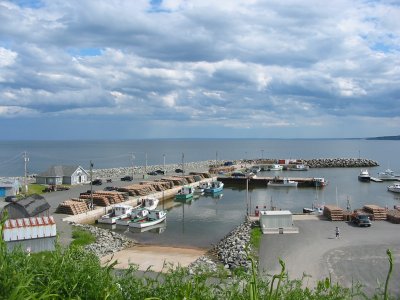« June 2007 | Main | September 2007 »
July 09, 2007
Strange places in Nova Scotia
Summer in Nova Scotia means (generally) good weather, and for The Sweetness and me, that means sojourning in the province and seeking out places we've never seen. Let me introduce you to some of these places, all of which we visited sometime this month.
The Culloden Cairn
Students of history may recall that the Battle of Culloden was a dark, dark day for Scotland. Scottish Highlanders rallied around their choice for the British throne, Bonnie Prince Charlie, and gathered to fight for him on April 16, 1746. Arrayed against them were the more numerous, and much better equipped, British army, supporters of the Hanoverian King George I. Sadly, it was no contest. Charlie lost and fled to France, the bagpipes were outlawed as a weapon of war, and George's grandson royally screwed up with the American colonies. It's all on Wikipedia.
What you probably didn't know: some of those Highlanders resettled in New Scotland. It's likely they considered this move an exile; they never forgot what happened at Culloden. Nor did their descendants, who erected a memorial cairn next to their graves. You can see it in Knoydart, down a forested path along the road from New Glasgow to Arisaig.
 | Written on the cairn: Let them tear our bleeding bosoms Let them drain our dearest veins In our hearts is Charlie, Charlie While a drop of blood remains |
Ballantyne's Cove, Secret Stronghold of Sushi
Okay, probably too much alliteration in the title. But this fishing village on the north coast of Nova Scotia really does hold an epic position in the industry of sushi, and nobody knows about it, even most Nova Scotians. You see, the water off Ballantyne's Cove is the place for fishing giant bluefin tuna from September to November. Some 200 boats will be there this fall, luring those 600-odd-pound creatures to hooks. Boat and fish will fight, often for hours, until somebody gives up (guess who?). The struggle makes the fish overheated, so the fishermen will let him swim around a little longer to cool down. Then it's curtains for the beast. Just one giant bluefin tuna will net the lucky boat thousands of dollars from the buyers on shore. These buyers, by the way? Almost all Japanese. This highlights two cruel ironies of Ballantyne's Cove:
1. It's a sleepy town the rest of the year, with nothing to show for their autumn drama except the modest, sparsely attended "Bluefin Tuna Interpretation Centre." I didn't see too many Japanese names in the visitor logbook. Yet across the water in Prince Edward Island, thousands of Japanese tourists are maxing out their JCB cards on Anne of Green Gables paraphernalia. I smell rotten marketing.
2. The delicate toro sushi, so beloved by Japanese and heartily consumed throughout the country, is made exclusively from the fatty portions of the very tuna that is fished from the waters of Ballantyne's Cove, Nova Scotia. Yet all of it ends up on airplanes at Halifax International Airport -- I can't get the stuff in town!
Oh well. It's a pretty place, at any rate.
 |
When Sinclair Discovered America
It's a law of publicity: everybody wants to be first, or, failing that, at least to be perceived as having been first. Nationalist sympathies often work to the advantage of fraudsters, since pride of place somehow gloms on to the reputation of all who hail from the same spot. Which explains why the Brazilians still get worked up about the Wright Brothers. And why this guy got so much press for saying the Chinese discovered America. So, then, it's surprising that the Sinclair story is so little known, especially with its currently trendy Dan Brown undertones.
Here's a summary: According to an apocryphal document published in 1558 and credited to the Zeno brothers of Venice, a certain Prince Zichmni traveled across the Atlantic in 1398. Johann Forster, a naturalist of Scottish descent, speculated in 1784 that this Zichmni was none other than Henry Sinclair, Earl of Orkney, sometime Templar Knight, and grandfather of the architect of Rosslyn chapel (which allegedly contains carvings of maize and other North American plants made prior to the Columbus voyage). Supposedly Sinclair traveled to Nova Scotia and made landfall near Guysborough on the eastern shore, where he dazzled the Mik'maq Indians enough to create legends of the white god Glooscap's visitation. He might also have built the Newport Tower, buried a knight in Massachusetts, and done many other weird and wonderful things in North America for the first time.
It's all a bit too Flat Earth for me, but maybe you can appreciate the narrative board we found in Halfway Cove (click to enlarge, and then read Brian Smith's rebuttal). It was accompanied by a large piece of granite with a plaque to "present the claim" and a self-referential monument "to the loyal and dedicated board of the Prince Henry Sinclair Society of North America Inc. ... without your support this simply lovely monument would not be here as a testimony to the story." The signage from the road was very good. Maybe somebody in the Nova Scotia government has Sinclair sympathies?
 |
Posted by The Greatness at 09:45 AM | Comments (0)